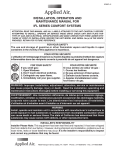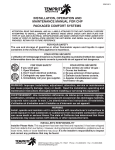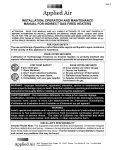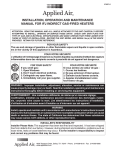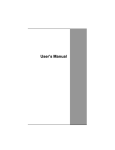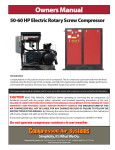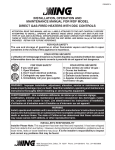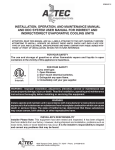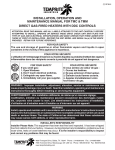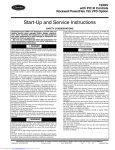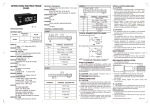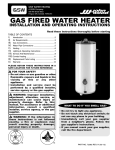Download Installation/Operation Manual for IFL
Transcript
IOMIFL-1 INSTALLATION, OPERATION AND MAINTENANCE MANUAL FOR IFL COMFORT SYSTEMS ATTENTION: READ THIS MANUAL AND ALL LABELS ATTACHED TO THE UNIT CAREFULLY BEFORE ATTEMPTING TO INSTALL, OPERATE OR SERVICE THESE UNITS! CHECK UNIT DATA PLATE FOR TYPE OF GAS AND ELECTRICAL SPECIFICATIONS AND MAKE CERTAIN THAT THESE AGREE WITH THOSE AT POINT OF INSTALLATION. RECORD THE UNIT MODEL AND SERIAL No.(s) IN THE SPACE PROVIDED. RETAIN FOR FUTURE REFERENCE. FOR YOUR SAFETY The use and storage of gasoline or other flammable vapors and liquids in open containers in the vicinity of this appliance is hazardous. POUR VOTRE SÉCURITÉ L'utilisation et l'entreposage d'essence ou d'autres liquides ou produits émettant des vapeurs inflammables dans des récipients ouverts à proximité de cet appareil est dangereux. FOR YOUR SAFETY If you smell gas: 1. Open Windows 2. Don’t touch electrical switches. 3. Extinguish any open flame. 4. Immediately call your gas supplier. c POUR VOTRE SÉCURITÉ Si vous sentez une odeur de gaz : 1. Ouvrez les fenêtres. 2. Ne pas actionner d'interrupteur. 3. Éteindre toute flamme ouverte. 4. Appelez immédiatement votre fournisseur de gaz. WARNING: Improper installation, adjustment, alteration, service or maintenance can cause property damage, injury or death. Read the installation, operating and maintenance instructions thoroughly before installing or servicing this equipment. AVERTISSEMENT: Une installation déficiente, de même qu'un mauvais réglage, modification, entretien ou maintenance peuvent occasionner des dommages matériels, corporels voire causer la mort. Lire attentivement les instructions d'installation, d'utilisation et d'entretien avant d'installer ou d'intervenir sur cet appareil. WARNING Install, operate and maintain unit in accordance with manufacturer's instructions to avoid exposure to fuel substances or substances from incomplete combustion which can cause death or serious illness. The state of California has determined that these substances may cause cancer, birth defects, or other reproductive harm. INSTALLER'S RESPONSIBILITY Installer Please Note: This equipment has been test fired and inspected. It has been shipped free from defects from our factory. However, during shipment and installation, problems such as loose wires, leaks or loose fasteners may occur. It is the installer's responsibility to inspect and correct any problems that may be found. 4830 Transport Drive, Dallas, TX 75247 Phone: 214-638-6010 Fax: 214-905-0806 www.appliedair.com SECTION I – FOREWORD As is the case with any fine piece of equipment, care must be taken to provide the proper attention to the operation and maintenance detail of this machine. This manual of instructions has been prepared in order for you to become well acquainted with those details, and in doing so, you will be able to give your IFL Indirect Fired Comfort System the care and attention which any piece of equipment needs and deserves. Table of Contents Section I: Foreword and Table of Contents ................. 2 Section II: General Information ................................... 3 Section III: Installation ................................................ 5 Section IV: Pre-Start Up ........................................... 11 Section V: Unit Start Up ............................................ 13 Section VI: Unit Shut Down ....................................... 15 Section VII: Troubleshooting ..................................... 16 Section VIII: Flue Gas Analysis ................................ 19 Section IX: Maintenance Schedule and Lubrication Requirements ...................... 20 Section X: Replacement Parts .................................. 23 Section XI: Typical Wiring Diagram ........................... 23 IMPORTANT NOTICE Applied Air assumes no responsibility for loss or damage in transit; therefore, you should protect yourself by following these instructions. Failure to do so is your responsibility. BILL OF LADING Save your bill of lading. It is a contract, and you will need it, provided you have to file a loss or damage claim. Remember, claims are outlawed after nine months. LOSS IN TRANSIT Before you sign for this shipment, check against the bill of lading, also the transportation company’s delivery ticket. Make sure that you get the exact total of articles listed. Should the delivery ticket show more or less items than you are offered, then the carrier’s agent must mark the difference on your freight bill before you sign. VISIBLE DAMAGE IN TRANSIT If something is damaged, accept the shipment only if the carrier’s agent places a notation on your freight bill explaining the nature and extent of damage. Upon inspection of article, make claim to the delivering carrier. CONCEALED DAMAGE IN TRANSIT Sometimes transit damage is not noticed until the goods are unpacked. In such cases, notification to the carrier must be made within fifteen (15) days of receipt of shipment. In such cases, save the packages and packing material, then notify the transportation company at once, and request an inspection. When the inspector calls, have him make out and leave a “concealed” bad order report. He is obliged to give you one. Insist on it. DISPOSITION OF DAMAGED ARTICLES Never return damaged articles to us. They are the property of the transportation company when the claim is filed. They will give you disposition instructions. PACKING We comply with the packing requirements of the transportation companies, and your bill of lading proved that everything was in good condition when shipped. That bill of lading contract requires them to deliver in perfect condition. –2– SECTION II – GENERAL INFORMATION A. Purpose The purpose of this manual is to present a guide for proper installation, maintenance, and operation of the IFL Indirect Fired Comfort System, and supplement, but not to replace, the services of qualified field service personnel to supervise the initial start-up and adjustment of the unit. Persons without previous experience with large commercial and industrial heating and cooling equipment should not attempt the initial adjustment and checkout procedure, which is essential before such installations may be considered ready for operation. This manual should be made readily available to all operating personnel as an aid in troubleshooting and proper maintenance. Due to the custom nature of Applied Air equipment, not all possibilities are addressed in this manual. The customer or installer can obtain information from Applied Air’s sales representative or the Applied Air factory. B. Shipping Base IFL Indirect Fired Comfort Systems are shipped completely assembled where shipping limitations allow. Optional inlet hoods, filter and/or damper sections, or other large accessories are assembled and shipped mounted and wired whenever possible within limitations of shipping and handling. Some optional accessories shipped separately may require field assembly. Any wired accessories, which have been disassembled for separate shipment, require no additional conduit or wire for field reassembly. All wire leads will be tagged for ease of reconnection in the field. If the unit and/or accessories cannot be installed immediately, they should be stored in a clean dry environment. If this is not possible and the unit must be stored outdoors, it should be protected from the weather with tarpaulins or plastic coverings. Do not assume that simply covering a unit will keep insects, dust, and condensation out of the unit and critical components. Rotate the fan monthly. All IFL Indirect Fired Comfort Systems are given a complete operations test and control circuit checkout before shipment. Copies of the wiring diagram, piping diagram and bill of material are included with each unit shipped. If correspondence with the factory is necessary, please provide the unit model and serial number. C. Optional Factory Service Periodic service on any piece of mechanical equipment is necessary for efficient operation. A nationwide service support network is available to provide quick and dependable servicing of make-up air, heating, ventilating, or air handling types of equipment. The factory also offers start-up service, which includes the presence of a service engineer to supervise the initial start-up and adjustment of the equipment and provide instructions for the owner’ maintenance personnel in proper operations and maintenance. Consult factory for quotations on periodic or start-up service. D. Curb Mounted Units Outdoor units can be supplied with an optional roof curb. The curb greatly facilitates installation thereby reducing installation costs. All connections to the unit: duct, piping, electrical power and control wiring can be made through the roof opening. The curb may be shipped prior to unit shipment. All curbs are shipped un-assembled from the factory. Use extreme caution in handling the curb. Proper handling and positioning will assure a water-tight curb unit installation. Re-check approval prints prior to installation. Be sure that there are no obstructions to ducting and that proper planning has been exercised in connection of piping and/or electrical services. Shipments are made F.O.B. Dallas, Texas by truck. The unit is securely strapped, tied, and blocked to prevent shipping damage. All shipments are checked by an inspector before they are accepted by the carrier. Parts that are shipped un-mounted are noted on the bill of lading. These parts, where feasible, are packaged and shipped with the unit. Upon receipt of shipment, all units should be checked against the bill of lading to insure all items have been received. All equipment (and any optional accessories) should be checked carefully for physical damage in the presence of the carrier’s representative. If parts are missing or damage has occurred, you should request an inspection, and a claim should be filed immediately with the carrier. The curb assembly may be bolted or welded to either trusses or roof decking; however, connection to roof trusses is recommended. The curb is designed to carry the weight of the unit. Additional support is required for certain applications.w Placement of the curb is critical in squareness and leveling. Shims for leveling must be applied to the curb; application of shims to the unit will tend to destroy the sealing effect after installation. Make sure sealing tape is in place before unit is set. Be careful not to allow gaps where two pieces of sealing tape meet. A bubble level must be used in leveling process. Measure across diagonals to check for squareness. Allowable tolerance is 1/4" difference between diagonal measurements. Double-check approval prints before setting the unit. –3– Upon completion of setting the curb, apply roofing material and flashing as required. All electrical connections must conform to the current edition of: ANSI/NFPA No 70 National Electrical Code and applicable state and local codes; in Canada, to the Canadian Electrical Code, Part 1 CSA Standard C22.1 and applicable provincial and local codes. E. Location Of Accessories Where applicable, standard or optional accessories will be placed inside the fan section of the unit for shipment, and must be removed and installed by the mechanical or electrical contractor. Remotely located discharge or inlet dampers must be equipped with an end switch and interlocked to insure maximum design opening before starting and running circuits may be energized. Since shipment of unit may require disassembly after factory check and test, reconnection of some electrical devices will be required in the field. Connect electrical wires (supplied in factory furnished conduit) to appropriate terminals. All leads are tagged to facilitate field connections. See wiring diagram provided with equipment. Complete all wiring to any optional accessories as shown on unit bill of material and electrical wiring diagram as required before applying voltage to the unit. Field constructed intake accessories should be properly designed to minimize the entry of rain and snow. Adequate building relief must be provided, so as to not over-pressurize the building, when the unit is operating at its rated capacity. This can be accomplished by taking into account, through standard engineering methods, the structure’s designed infiltration rate, by providing properly sized relief openings, by interlocking a powered exhaust system, or by a combination of these methods. F. Electrical Connections WARNING: Open all disconnect switches and secure in that position before wiring unit. Failure to do so may result in personal injury or death from electrical shock. WARNING: Controls must be protected from water. Do not allow water to drip on the ignition system. Entry location for all field installed and control wiring is through the control panel. If optional disconnect is not furnished with heater, the field provided disconnect must be of the proper size and voltage. Refer to unit nameplate for minimum circuit ampacity and voltage. The disconnect must be installed in accordance with Article 430 of the current edition of ANSI/NFPA No. 70 National Electrical Code. Check the supply voltage before energizing the unit. The maximum voltage variation should not exceed + 10%. Phase voltage unbalance must not exceed 2%. NOTE: Should any original wire supplied with the heater have to be replaced, it must be replaced with wiring material having a temperature rating of at least 105o C. REMARQUE: Dans le cas où un quelconque des câbles livrés avec l´unité devait être remplacé, il doit être remplacé avec des câbles prévus pour résister à une chaleur d´au moins 105°C. NOTE: Before installing any wiring, check the unit rating plate for supply power rating. –4– SECTION III – INSTALLATION Prior to beginning installation of a unit that has been in storage for weeks or months, the unit and its components should be closely inspected. CAUTION: Heating system must not be installed in locations where air for combustion would contain chlorinated, halogenated or acidic vapors. If located in such an environment, premature failure of the unit will occur! FOR CANDIAN INSTALLATIONS ONLY 1. All installations must conform with local building codes, or in the absence of local codes, with current CAN/CGA-B149-Installation Codes for Gas Burning Appliances and Equipment. A. Handling The Equiment The IFL Indirect Fired Comfort System has been designed for rigging and handling through the use of special lifting lugs installed on the base of each unit. As explained previously, the basic unit is designed for shipping in one piece where shipping limitations allow. Some optional accessories may require field mounting. 2. All electrical connections must be in accordance with Canadian Electrical Code, Part 1, CSA Standard C22.1. All electrical connections must conform to the current edition of ANSI/NFPA No. 70 National Electrical Code and applicable local codes: in Canada, to the Canadian Electrical Code, Part 1, CSA Standard C22.1. The following recommendations are not intended to supplant any requirements of federal, state, or local codes having jurisdiction. Authorities having jurisdiction should be consulted before installations are made. Local codes may require additional safety controls and/or interlocks. During lifting operations, slings or chains with hooks and I-beam spreader are recommended, see figure below. Lifting must be equal to all lugs furnished. The spreader bar (I-beam or equal) must be equal in length to the longest span between lifting points. Depending on sling length one or more spreaders are recommended. In no case should the lift be less than 80-degrees from horizontal or more than 30-degrees from threaded shank direction. When unloading and setting the unit, use the lifting points provided or move the equipment on rollers. Hooks, jacks, or chains must not be used around the casing, main control panel or exterior mounted controls. All installations in airplane hangers must be in accordance with current ANSI/NFPA No. 409. All installations in public garages must be in accordance with current NFPA No. 88A and NFPA No. 88B. CAUTION: Do not install heating system in corrosive or flammable atmospheres! Premature failure of, or severe damage to the unit will result! During transit, unloading and setting of the unit, bolts and nuts may have become loosened, particularly in the pillow block ball bearing assemblies in the fan section. It is recommended that all nuts and setscrews be tightened. Turn fan shaft by hand to make certain that wheel does not rub against venturi, and that bearing setscrews are tight. Open the cover on the electrical control box located on the unit and ensure that all connections are tight. IFL Rigging –5– B. Locating The Unit Prior to locating the unit, authorities having jurisdiction should be consulted before installations are made. Approval permits should be checked against the unit received. For indoor application, combustion air shall be provided at a rate of at least 10 CFM, or 1 square inch of free opening, per 1000 BTU per hour of rated input. If a separate mechanical means provides this air, an interlock with the combustion blower shall be provided. The rated output of gas burning appliances decreases with higher altitudes above 2,000 feet, the furnace shall be de-rated 4% for each 1,000 feet of altitude above sea level. Factory testing rating plate information is recorded on sea level conditions. High altitude ratings may be obtained by a change in manifold pressure. Appliances must be suitably marked to indicate their altitude adjusted input rating. Under no circumstances should this equipment be installed in a negatively pressurized space. Consult jurisdictional authority for proper ventilation requirements. Combustion air containing or recirculation of room air may be hazardous in the presence of: a) Flammable solids, liquids and gases. b) Explosive materials (i.e., grain, dust, coal dust, gunpowder, etc.) c) Substances, which may become toxic when, exposed to heat (i.e., refrigerant, aerosols, etc.). Locate the unit exactly level. Special attention should be given to the duct, electrical, and fuel connection points. Install ductwork with adequate flexible connection to isolate vibration from the ductwork. All ductwork should have taped or caulked seams. Ductwork should be properly sized so as not to inhibit airflow. This information should be crossed-checked with the position of support beams and stand pipes to insure that clearance dimensions coincide with those of the unit. NOTE: Return air units must be ducted. The minimum clearance to combustible material must be maintained as listed in Table 1. Table 1 Minimum clearance to combustible material, also consult local codes and regulations. Clearances to Combustible Material Horizontal Units Front* 48 Inches Rear 18 Inches Right 18 Inches Left 18 Inches Top 18 Inches Floor 6 Inches * Consider control side as front of unit. In addition to the combustible clearances listed above, access for service should be allowed around the unit. The recommended minimum access is 36" on front and rear sides for service access. Optimum clearance for coil removal for units with cooling coil section would be equivalent to cabinet width. Field Assembly Drawing A FL IR OW C000660 –6– On outdoor curb mounted installations, flash and seal the roof curb to prevent leakage. The cross section of factory provided curb is formed to accept wood nailing strip and insulation provided by others. It is the customer and installation personnel responsibility to determine if the unit is equipped with all of the safety devices required for the particular application. Safety considerations include the accessibility of the unit to non-service personnel, the provision of electrical lockout switches, maintenance procedures, and automatic control sequences. Clearly mark all emergency shutoff devices. If optional disconnect is not furnished with the unit, the field provided disconnect must be of the proper size and voltage. Refer to unit nameplate for minimum circuit ampacity and voltage. The disconnect must be installed in accordance with Article 430 of the current edition of ANSI/NFPA No. 70 National Electrical Code, and applicable local codes; in Canada, to the Canadian Electrical Code, Part 1, CSA Standard C22.1. Check the supply voltage before energizing the unit. The maximum voltage variation should not exceed + 10%. Phase voltage unbalance must not exceed 2%. NOTE: Should any original wire supplied with the unit have to be replaced, it must be replaced with wiring material having a temperature rating of at least 105o C. C. Location Of Accessories Where applicable, standard or optional accessories will be placed inside the fan section of the unit for shipment and must be removed and installed by the mechanical or electrical contractor. Remotely located discharge or inlet dampers must be equipped with an end switch and interlocked to insure maximum design opening before starting and running circuits may be energized. E. Venting All venting installations must conform to Part 7, Venting of equipment in the current version of the National Fuel Gas Code ANSI Z223.1, or applicable provisions of local building codes. D. Electrical Connections All indoor units must be vented. Each unit must have an individual vent pipe and vent terminal. The customer must provide a rain cap or weatherproof cap. Insulate single wall vent pipe exposed to cold air or running through unheated areas. Warning: Open all disconnect switches and secure in that position before wiring unit. Failure to do so may result in personal injury or death from electrical shock. Warning: Controls must be protected from water. Do not allow water to drip on the electrical controls. Note: Before installing any wiring, check the unit rating plate for power supply voltage, and minimum amperage. All wiring must comply with all applicable local, state, provincial, and national electric codes. Since shipment of unit may require disassembly after factory check and test, reconnection of some electrical devices will be required in the field. Connect electrical wires (supplied in factory furnished conduit) to appropriate terminals. All leads are tagged to facilitate field connections. See wiring diagram provided with equipment. Complete all wiring to any optional accessories as shown on unit bill of material and electrical wiring diagram as required before applying voltage to the unit. Entry location for all field-installed and control wiring is through the control panel. A vent connector shall be equivalent to a minimum of 24 gauge galvanized steel. It shall have a minimum of at least 9” to combustible material. All horizontal runs should have a minimum rise of 1/4“ per foot of horizontal run. Support horizontal runs as required to prevent sagging. Refer to the rating plate for the category of appliance to select the venting system. Consult the authorities having jurisdiction, and use a gastight watertight venting system constructed of material resistant to corrosion by condensate. The National Fuel Gas Code, ANSI Z223.1, specifies a 4 foot (1.22m) horizontal vent terminal clearance from gas and electric meters, regulators and relief equipment. The Canadian B149.1, Natural Gas Installation Code specifies a 6 foot (1.83m) horizontal vent terminal clearance to gas and electric meters and relief devices. Through the wall vents for these heaters shall not terminate over public walkways or over an area where condensate or vapor could create a nuisance or hazard or could be detrimental to the operation of regulators, relief valves, or other equipment. –7– The vent pipe diameter must be as shown in following chart. WARNING: To avoid equipment damage or possible personal injury, do not connect gas piping to this unit until a supply line pressure/ leak test has been completed. Connecting the unit before completing the pressure/leak test may damage the unit gas valve and result in a fire hazard. Minimum Stack Diameter 200 MBH Input 4" 400 MBH Input 6" 600 MBH Input 7" Any exhaust stack shall have a minimum of at least 36” clearance to combustible material. DANGER: Never use an open flame to detect gas leaks. Explosive conditions may exist which would result in personal injury or death. The vent pipe should be fitted with a drip leg with a clean out and a drain plug in the bottom. The vent pipe shall be constructed so that any water that collects in the stack will remain in the stack drip leg and not drain into the heater collector box. Be sure drip leg is made so water will not fall on heater controls when drain plug is removed. Vents should terminate that will not cause a down draft to occur. This could affect the over-fire draft pressure in the heat exchanger. Do not install dampers or other restrictive devices in the flue vent pipe. The stack should not be installed in such a manner that access to the components is obstructed. Guy wires may be required to brace the stack above rooflines. The gas line should be supported so that no strain is placed on the unit. Pipe compounds, which are not soluble to liquid petroleum gases, should not be used on threaded joints. The appliance and its individual shutoff valve must be disconnected from the gas supply piping system during any pressure testing of that system at test pressures in excess of 1/2 PSIG. The appliance must be isolated from the gas supply piping system by closing it’s individual manual shutoff valve during any pressure testing of the gas supply piping system at test pressure equal to or less than 1/2 PSIG. Correctly sized piping must be run to the unit. Outdoor units are supplied with a stack. The stack shall have a minimum of at least 36" clearance to combustible materials. The pressure measured with a manometer at the test port in the burner compartment must not exceed the “Maximum Overfire Positive” pressure on positive fired heaters. The flue draft should be adjusted at the damper of the burner fan when the heater is operating on high fire. F. Field Piping All gas piping must be in accordance with the requirements outlined in the National Fuel Gas Code – ANSI Z223.1. It is required that a ground union be installed adjacent to the manifold for easy servicing. A drip leg and/or filter should be provided upstream of the unit’s inlet gas connection. An additional shut-off must be located external of the unit’s enclosure where required by local code. The location of this valve must comply with all local codes. A 1/8 inch N.P.T. plugged tapping, accessible for test gauge connection, must be installed immediately upstream of the gas supply connection to the unit. Please note that gas line pressure must be as shown on specification plate when unit is operating at full input. The high-pressure regulator and relief valve should be, if possible, mounted at least 5 to 10 feet upstream from the appliance regulator on the unit (if applicable). G. Field Wiring and Remote Control Installation 1. Connect the power lines to the line side of the power distribution block or optional main disconnect switch. 2. Field wiring is indicated on the wiring diagram typically as dashed lines. Where field wiring of the control circuit is required, take care to size the wires for a maximum 10% voltage drop. The VA rating of the transformer should be the maximum load. 3. Mount and wire remote control panel, thermostat temperature sensors, and any other field-installed controls as indicated on the unit control-wiring diagram. 4. Connect all wiring to the appropriate field wiring terminal and any shielded or twisted wires as indicated on the unit control-wiring diagram. –8– H. Locating Temperature Controls The room or outdoor thermostats should be mounted where they will not be subjected to direct impact of the heated air or radiant heat from the sun. It is also recommended that the thermostats, especially those with mercury bulb contacts, be mounted on a vibration free surface. The sides of building columns, away from the heater or interior walls, are usually the location best suited for mounting thermostats. Controls with outdoor bulbs require that the outdoor bulb be shielded from direct radiation from the sun. Unit mounted sensors are factory located and mounted. I. Drains and Traps Heat Exchanger – Some furnaces may be supplied with condensation removal pipe connections. Condensate from the heat exchanger is acidic and may contain chemical compounds requiring special drainage. The drain must be installed in accordance with all plumbing codes. The condensate is to be drained via PVC or steel pipe with an indirect connection to the plumbing wastes. Where a condensate neutralizer is used, an overflow shall be provided such that condensate will be directed to the drain in the event that the neutralizer becomes plugged. Indoor units typically require a condensate trap to be installed to prevent combustion gasses from entering the space. Outdoor units may require installing a heat trace or special attention to drains to prevent freezing and clogging of the drain line. Evaporator Coil – The cooling coil section is located in the unit so that supply air is drawn through the evaporator coil(s). This results in the condensate being induced to the area of low static pressure. Unless some means of pressure equalization is provided in the condensate drain, the air rushing through the drain will cause the condensate to accumulate in the drain pan. As the unit continues to operate, the accumulated water will be picked up by the in-rushing air and carried with the air over the side of the drain pan causing possible water leaks into the supply duct and/or through the bottom of the unit causing water damage in the building. A trap should be installed to prevent this condensate water buildup. See drawing below. On initial startup, it may be necessary to fill the trap manually or, after unit has operated sufficiently for a small amount of condensate to collect in the drain pan, turn off the unit and the trap will automatically fill. During the winter months when the cooling system is turned off and the unit is exposed to freezing conditions, an antifreeze solution should be poured into the condensate pan trap to prevent freezing and possible damage. The condensate drain trap may also be drained and capped, but be sure to remove the cap when starting the cooling for the next season. NOTICE TO INSTALLER Complete the following information: Since the condensate is drained by gravity, avoid long runs of drain piping. If a long run of trapping cannot be avoided or the piping has water flow restrictions such as several elbows, add extra height to provide enough hydrostatic head to overcome the frictional losses. Always slope piping down a minimum of 1/8" per foot in the direction of the flow. Refrigerant Type ______________________ Refrigerant Pressure____________________ Condenser Type _______________________ Condensate Drain Drawing C000659 –9– Coil Assembly and Piping Drawing – 10 – SECTION IV – PRE START-UP Do not attempt start-up without completely reading and understanding this manual. Pre Start-Up The owner’s representative or equipment operator should be present during start-up to receive instructions on care and adjustments of the equipment. Before starting up this equipment, study and familiarize yourself with the wiring diagram, sequence of operation, flame safeguard, control components, gas train, and burner. Check any dampers or mixing boxes (if supplied). Make certain that all damper linkage is free to move and no binding will occur. If dampers are of the modulating type, check control capillary tubes to insure that the tubes and bulbs are in the proper location and will not rub against any other parts. All equipment has been factory tested, adjusted, metered and inspected to meet conditions set at the time the order was placed. Only minimal adjustments should be required. All information in this service manual is typical. All products are semi-custom and changes may occur. The following procedures should be performed to assure the unit has not been damaged or misaligned during shipping. Check to make sure all vent lines (if applicable) are run to atmosphere on gas regulators and pressure switches. Vent lines should terminate outside the building, with a turndown elbow and bug screen. Vent limiters may be used which do not require vent lines to be run. If vent lines are even partially plugged, this will interfere with the proper venting of pressure control devices. NOTE: All servicing and adjustments to the Indirect Gas Fired unit should be performed by a qualified service engineer. CAUTION: Line side of disconnect switch may be energized. Follow proper “lockout/tagout” procedures. Perform a visual inspection internally and externally of the unit to make sure no damage has occurred, and everything is secure. This inspection is very important and should be completed with greatest care given to detail. A good pre-start inspection will insure against possible unit damage on start-up and will save valuable analysis time. Check to make sure all filters, accessories, and ship loose items are installed correctly. Check to make sure the flue stack is installed properly and free from obstruction. Check all thermostats for normal operation. Check to make sure all manual reset safety devices have been reset, and limits are in their normal operating position. Check that the physical condition of the unit exterior is acceptable. Check to make sure all doors and inspection panels are secured or closed. Check that the insulation inside of unit is properly secured. Check that all piping connections, particularly unions, are tight. Check all gas piping for leaks using a soap bubble solution. The most common types of problems found relative to the gas train itself is foreign material within the gas piping. This will interfere with the proper operation of the gas train components and burner. Purge all air from gas lines per gas codes. Remove all shipping blocks, brackets, and bolts from bases on units with optional isolation base. Check that system ductwork is installed properly and free from obstructions. Check to make sure blower turns freely. Check all wiring for loose connections and tighten if necessary. Check that all manual gas valves are closed. Inspect all blower and motor bearings and lubricate if necessary. Optional extended lube lines are shipped filled from the factory. CAUTION: Do not attempt to start the burner when furnace is full of vapor or combustion chamber is very hot. Inspect sheaves and belts for tightness, tension and alignment. Do not over tighten belts. Inspect setscrews on bearings and blower for tightness. Connect test instruments, thermometers, and meters on the furnace and controls to measure and record the appropriate data. CAUTION: OVER GREASING BEARINGS WILL RUPTURE GREASE SEALS. – 11 – Suggested Tools and Instruments Volt/Ohm meter Tachometer Stack and Temperature Thermometer Gas Pressure Gauge Ammeter/Amprobe (or equal) U-Tube Manometer (0-10” W.C.) Flue Gas Test Equipment Standard Hand Tools D.C. Volt Meter BEFORE ATTEMPTING TO START THE HEATER, READ THE TYPICAL SEQUENCE OF OPERATION AS SHOWN BELOW: Typical Sequence of Operations Note: This sequence is written for only the burner safety and operating portion of the heater. Other control systems for dampers, mixing boxes, and temper-ature controls are included in the unit typical sequence of operation and/or wiring diagram: Microammeter FL-01 FL-02 FL-02 FL-04 PS-02 PS-04 PS-07 PS-12 RE-21 TC-09 Suggested Control Settings Fan Control ...................................... 95o-125oF High Limit (Horz Discharge) ...................210oF High Limit (Down Discharge) ..................230oF Auxiliary High Limit……………………….210oF Burner Proving Switch ......................... Adjust to field condition Low Gas Pressure Switch ............................................... 1.0" W.C. High Gas Pressure Switch ...............125% above burner firing rate Clogged Filter Switch ......................... Adjust to field condition Time Clock ...................... Customer Discretion Night Setback Thermostat ..................... Customer Discretion See Digital Control System User’s Manual for DDC Controller default settings. 1. With main supply air blower on, thermostat calling for heat, and all switches and operating controls in their normal position, the burner motor will run and “pre-purge” the combustion chamber. Pre-purge timing is not adjustable and is approximately 30 to 90 seconds. 2. With pre-purge timing complete, the pilot solenoid (if applicable) and ignition transformer are energized. The pilot/burner flame will be established and sensed by the flame sensor. 3. Ignition transformer is de-energized and pilot valve remains on (if applicable). 4. Main fuel valve(s) will open. The main burner flame will be established. 5. Pilot valve (if applicable) is de-energized. 6. Once thermostat is satisfied, the main fuel valves(s), and burner motor will be de-energized. Main supply air blower will continue to run. – 12 – SECTION V – UNIT START-UP A. PURPOSE Check the incoming line voltage to match unit nameplate rating. If voltage is over + 10% of nameplate rating or phase voltage unbalance is over 2%, notify contractor or the power company. Check the gas supply pressure to the heater, making sure it does not exceed the maximum on the unit rating plate. If power supply meets requirements turn main disconnect switch on. Turn Fan “on-off” switch to “on” position. Inlet shut-off damper (if applicable) opens, after end switch has proven damper is open the blower runs. Connect the test instruments, meters, and thermometers on the heater and controls to measure and record the appropriate data. Close the main manual valve, leaving the pilot valve open (if applicable). Set the thermostat at the highest setting and energize the heating control – burner motor starts, closing the air switch and energizing the ignition control. Turn Fan “on-off” switch to “off” position. Check supply blower for proper rotation. The burner rotation can be checked when the heat section is started. With power supplied to the ignition controller and all the safety limiting devices are satisfied, a 30-90 second pre-purge will start, the pilot valve (if applicable) or main gas valve is energized and a 6-15 second trial to ignite. If the flame sensing probe fails to prove the pilot or main flame, it de-energizes the spark igniter and the controller will lockout on flame failure (10-30 seconds). This safety step is performed to establish the flame sensing, and test any of the safety devices before main burner light off. NOTE: To change rotation of the blowers, simply interchange any two (2) of the line leads of the motor starter for three phase motors. On singlephase motors, refer to motor nameplate. Turn Fan “on-off” switch to “on” position. Check for proper blower RPM. Check that all amp draws do not exceed nameplate ratings and overloads are set to nameplate amps. Check to make sure all dampers and controls are working properly. Turn Fan “on-off” switch to “off” position. Make sure all manual gas shut-off valves are still in the closed position. Setting Burner CAUTION: Do not attempt to start the burner when furnace is full of vapor or combustion chamber is very hot. NOTE: When setting up the burner for the first time or if the appliance has been shut down for an extended period of time, these same start-up procedures should be followed. Refer to burner manufacturer’s Installation, Operation, and Maintenance instructions for proper set-up, operation, and settings. Turn the main and pilot (if applicable) manual shutoff valves upstream of the firing rate valve on and check for leaks in the gas piping using a soap bubble solution. Correct any leaks that are found. Frequently the cause for safety lockouts relates to gas pressures that are too high, and/or combustion air dampers that are not set correctly. For units with pilot, cycle pilot several times to make sure that the combustion air and pilot gas pressure is sufficient to provide instant ignition and you have a steady flame. Check to make sure the pilot flame signal is steady. Pilot regulator adjustment may be necessary if the adjustment of the needle valve does yield the required flame signal. Install a manometer at the test port to check burner manifold pressure. Once pilot has been established (if applicable), the main manual valve is turned on. Reset the controller and the ignition sequence will recycle. Once the main automatic gas valve is energized the burner will light, and the control valve will modulate to thermostat setpoint. Check to make sure the main flame signal is steady. If the burner does not light within a few seconds after pre-purge shut the burner off and repeat the previous steps. – 13 – Check the combustion air setting. The duct furnace has been test fired in the factory for firing rate and combustion. Field conditions may require adjustments to be made. These checks should be done by a qualified service man. a) When the main flame is established, check the gas manifold pressure at the test points nearest the burner, downstream of the gas control valve. Check the nameplate for the correct pressure and adjust the appliance regulator if necessary. b) Check the CO and O2 reading at maximum and minimum inputs shown on the rating label. O2 readings typically range from 4-10%. CO readings should not exceed 400 PPM at any time. Adjust the air/gas ratios with the control linkages making fine adjustments before measuring again. c) Ensure proper overfire draft at test port in burner section is set per nameplate. d) Visually observe the flame and insure that the flame does not impinge on the heat exchanger surface and that there are no hot spots on the combustion chamber. e) Check all gas piping again for leaks using a soap bubble solution. f) When the duct furnace installation is complete, recheck the amperage draw of each motor. g) Insure all safety controls are operative, i.e., flame relay, high limit, air proving switches, etc. h) Reset all operating controls back to proper setpoints for normal running conditions. FINAL CHECKS AND ADJUSTMENTS With the gas input pressure established, the flue gas analysis can now be preformed. This is done at the stack. The following readings should be taken but not limited to: CO2% Net Stack Temperature O2% Combustion Efficiency CO % If necessary, make adjustments on burner air shutter. DO NOT change the fuel input rate. The following list covers general combustion problems and some of the possible cures. Conditions may vary in the field. Refer to combustion chart for efficiency. CAUTION: Check local codes for maximum allowable percentages and amounts of emissions. Low Carbon Dioxide (CO2) • Fuel input too low • Excess burner air • Wrong draft setting Detectable Carbon Monoxide (CO) • Fuel input too high • Not enough burner air • Restricted draft • Flame impingement Excessive Stack Temperature • Draft setting too high • Excess burner air • Fuel input too high Low Oxygen (O2) • Oxygen reading must always be a positive percentage Cycle burner several times to ensure smooth light off and proper operation. Visually observe the flame pattern. There must be no flame impingement or hot spots on the combustion chamber that could cause scaling. Check voltage and amperage on all motors. Check all dampers, linkages, and locking quadrants to make sure they are secure and operating correctly. – 14 – SAFETY AND CONTROLS CHECKOUT Flame Safeguard – Close the last manual gas valve before burner. Operate unit in heat mode. After pilot flame has been established, close manual pilot gas valve (if applicable). The flame safeguard must trip out within 15 seconds. Air Pressure Switches – The air pressure switches can be checked by turning the adjusting screw to call for a higher pressure than is normally used on the system. Recycle is automatic when the switch returned to its original setting. If the burner or draft proving switches open, this could cause the flame safeguard to go into lockout mode. Limit Controls - The limit controls are checked by adjusting control to a lower temperature setting while the unit is operating on high fire and observe cut-off. Return the adjustment to its original setting. Manual reset may be required on some controls. Gas Pressure Switches – The low gas pressure switch will trip out and must be reset before resuming operation when the inlet gas shut off valve is turned off, or inlet gas pressure is lower than the trip point. The high gas pressure switch can be checked by reducing the setting of its trip point lower than the burner operating pressure. The switch should trip out and shut off the burner. Return the adjustment to its original setting and reset to resume operation. Make sure all the safety and controls are working properly. Temperature Controls - The temperature controls are checked by adjusting control to a higher temperature to allow burner to cycle on. Adjust control to a lower temperature to allow burner to cycle off. Return the adjustment to its original setting. SECTION VI – UNIT SHUTDOWN A. Extended Shutdown 1. De-energize the heating control, turning the burner off. 2. Close the Manual Firing Valve in the heater gas piping manifold. 3. If the furnace was firing at the time of shutdown allow the main supply blower to run for a sufficient period to cool off the heat exchanger. The furnace may have an automatic blower override that will perform this function automatically, running the blower until the air reaches a fan cut-off temperature. 4. Turn the furnace control to the “off” position. 5. Turn the unit main power disconnect to the “off” position. 6. Close all the manual gas shut-off valves. 7. If the unit is to remain idle for an extended period, the blower and motor shafts should be rotated by hand to spread the grease over the bearings. B. Emergency Shutdown Only 1. Open the main electrical disconnect switch. 2. Close the main manual gas valve. – 15 – SECTION VII – TROUBLE SHOOTING Check Safety Shutdown Performance 1. Turn off gas supply. 2. Set thermostat or controller above room temperature to call for heat. 3. Watch for ignition spark either immediately or following prepurge cycle. See Flame Safeguard module specifications. 4. Time the length of the spark operation. See Flame Safeguard module specifications. 5. After the Flame Safeguard module locks out, open the manual gas valve and make sure no gas is flowing to the pilot or main burner. 6. Reset the Flame Safeguard module. 7. Operate system through one complete cycle. WARNING: Fire or explosion hazard. Can cause property damage, severe injury or death. Perform the safety shutdown test any time work is done on a gas system. NOTE: Read steps 1 through 7 before starting, and compare to the safety shutdown or safety lockout tests recommended for the Flame Safeguard. Where different, use the procedure recommended for the Flame Safeguard. Refer to manufacturer’s IOM for additional troubleshooting information. Symptom Cause A. Blower does not operate. 1. Low or no voltage. 2. Fuse(s) blown. 3. Customer’s interlock not closed or connected. 4. Fan “on-off” switch in “off” position. 5. Door switch open. 6. Freeze protection tripped. 7. Damper motor not operating, its end switch not making, or dampers binding. 8. Overload protection on motor starter tripped. 9. Belts loose or broken. 10. Motor may be burned or incorrectly wired. 11. Time clock or field installed controls not closed. 12. Night set back thermostat not closed. 13. Bearing seized on shaft. – 16 – Remedy 1. Check power source. 2. Replace fuse(s). 3. Close or connect customer interlock. 4. Switch to “on” position. 5. Close door. 6. Check stat and settings, reset by re-cycling the power. Check sensor and location. 7. Check for power at damper motor and that end switch has been wired correctly. End switch should be wired N.O. (normally open). Clear linkage. 8. Reset the starter by pushing red button on starter, check amp draw. 9. Turn power off and check belts. 10. Turn power off and check motor and wiring. 11. Check time clock and field installed controls for correct settings and voltage. 12. Check night set back thermostat for correct settings. 13. Turn power off and check bearings. SECTION VII - TROUBLE SHOOTING continued Symptom B. Burner motor does not operate. C. No voltage at flame safeguard relay input terminals. D. Flame safeguard relay goes into safety shutdown (Lockout). E. Pilot does not light after pre-purge has timed out and voltage is present on flame safeguard output terminals. Cause Remedy 1. Low or no voltage. 2. Fuse(s) blown. 3. Customer’s interlock not closed or connected. 4. Burner “Manual/Auto” switch in “Off” position. 5. Safety and limit circuits open. 1. Check power source. 2. Replace fuse(s). 3. Close or connect customer interlock. 4. Place switch in “Manual/Auto” position. 5. Close safety and limit circuits. 6. Ignition control not closed. 7. Overload protection on motor or starter tripped. 8. Motor may be defective or incorrectly wired. 9. Burner relay not closed. 10. Pre-purge timer not closed. 6. Check for power or replace. 7. Reset the motor or starter and check amps. 8. Turn power off and check power and wiring. 9. Check for power or replace. 10. Check for power or replace. 1. See burner motor does not operate Clause #1, 2, 3, 4, 5, & 10. 2. Burner motor air proving switch open. 1. See burner motor does not operate Remedy #1, 2, 3, 4, 5, & 10. 2. Check for correct rotation and/or adjust switch. 1. See technical data sheets on flame safeguard relay. 1. Manual pilot shut-off valve closed (if applicable). 2. Inlet gas pressure lower than minimum gas pressure required. 3. No gas through pilot regulator with sufficient inlet gas pressure (if applicable). 4. No gas flow through pilot solenoid valve (if applicable). 5. Type of gas supplied (natural gas or propane) different than shown on unit rating plate. 6. Flame detection system not sensing pilot flame. (See section for servicing burner). 7. No voltage on secondary side of ignition transformer. – 17 – 1. Determine the cause of lockout. Reset the flame safeguard relay. 1. Slowly open valve. 2. Increase gas pressure. 3. Clear obstruction in vent orifice or line, replace if defective. 4. Check for proper installation, and voltage. Correct or replace if defective. 5. Connect to proper fuel supply or contact factory for field conversion parts. 6a. U.V. Sensor – Clean lens, check wiring and spark rod. 6b. Flame Rod – Assure rod is in pilot flame, check wiring, and flame rod. 7. Check wiring. Replace transformer if defective. SECTION VII - TROUBLE SHOOTING continued Symptom F. If pilot does not light after pre-purge has timed out and there is no voltage at flame safeguard relay output terminals. G. If there is no heat with pilot OK (if applicable) and voltage is present at flame safeguard relay output terminals. Cause 1. See technical data sheets on flame safeguard relay. 1. Check wiring and replace if defective. 1. Manual gas shut-off valve closed. 1. Turn heat off-on switch to the off position. Slowly open all manual gas shut-off valves. 2. Clear obstruction in vent orifice or line. Check for correct size spring. Replace if defective. 3. Check wiring, voltage, and adjustment. Correct wiring or replace if defective. 4. Check wiring and replace if defective. 2. No gas on outlet side of regulator with proper inlet pressure. 3. No gas on outlet side of butterfly valve or actuator with proper inlet pressure. 4. Burner does not modulate. H. If there is no heat with pilot OK and no voltage is present at flame safeguard relay output terminals. Remedy 1. See technical data sheets on flame safeguard relay. – 18 – 1. Check wiring and replace if defective. SECTION VIII – FLUE GAS ANALYSIS – 19 – SECTION IX – MAINTENANCE Periodic maintenance is essential to the efficient operation and extended service life of this equipment. Failure to provide maintenance as recommended may void the equipment warranty. A. Maintenance Schedule 1. Daily a. Check gauges, monitors, instruments and equipment settings. b. Initial start up has a tendency to relieve the tightness of nuts, bolts, and setscrews on the blower, bearings, and burner assembly. Recheck for tightness of hold down bolts, all setscrews and keys, and tighten if necessary after approximately the first eight (8) hours of continuous operation. 2. Weekly a. Check that fan belts are tight and sheaves are aligned. CAUTION: Do Not Over Tighten Belts. The fan belts can be checked every 30 days after the first 60 days of new belt run-in. b. Check gas pressure at regulator. 3. Monthly a. Check all valves, piping and connections for leaks. b. Check the pilot and burner flame signal. c. Check the fuel pressure in the fuel supply line to each heater. d. Check the burner manifold pressure and draft. e. Do a flue gas analysis. f. Inspect filters. Clean or replace as necessary. g. Inspect main blower bearings; lubricate if necessary. See following section on bearing lubrication. h. Check all dampers, damper actuators and linkages. Adjust and tighten if necessary. i. Inspect area and make sure that no combustible or hazardous material has been stored within clearances as shown on the specification plate. j. Check for any vibration or unusual noise. If any is observed, locate the cause and correct. k. Ensure the supply, discharge, combustion air, vents, and stack remains clean and open. 4. Quarterly a. Complete the monthly maintenance schedule. b. Inspect all drives for proper belt tension, wear, and alignment. c. Check that bearings, blowers, and drives setscrews are securely locked to the shaft. d. Inspect the burner and pilot assembly. Clean and adjust if necessary. e. Check the voltage and amps on all motors. f. Check the operation of all safety limits and controls. Clean and recalibrate or replace. g. Check the operation of the automatic gas shut off valves, and check them for leakage at the pressure test ports provided. h. Inspect all electrical components, connections, and terminals. Clean or replace and tighten as necessary. 5. Off Season or Yearly a. Complete the monthly and quarterly maintenance schedules. b. Inspect blower wheel and clean if necessary. c. Check that blower wheel and sheaves are securely set to the shaft. d. Inspect all bearings and check condition and alignment. e. Inspect all fan belts and sheaves. Replace if necessary. f. Check the condensation lines for any leaks or blockages (if applicable). g. Test ignition spark. Adjust gap if necessary. h. Clean flame sensor, ignition electrodes, and check for cracks. i. Test the flame safeguard relay (RE-02) and replace components if necessary. j. Inspect all regulators, relief valves, motorized valves, solenoid valves, vent valves, manual shut-off valves, and safety shut off valves. Check their operation and clean or replace as necessary. k. Inspect and clean all drip legs in fuel lines and in the flue. l. Inspect the combustion chamber for carbon deposits, soot, scale or flame impingement. Clean if necessary. If there is evidence of flame impingement, complete burner adjustment must be made. m. Lubricate blower and burner motors as directed by motor manufacturer. Inspect motors for loose connections. n. Lightly oil all door latches. o. Check that the cabinet is weather-tight. Replace door gaskets and re-caulk as needed. – 20 – B. Lubrication Instructions NOTE: On totally enclosed fan cooled (TEFC) motors, the rear end fan housing must be removed to expose the grease plugs. Motor Manufacturer Bearing Type All 3 phase Baldor or equal Single row fan motors ball bearings (1 HP to 100 HP) ODP, TEFC Recommendation: See following note. 2. Pillow Block Bearings – Pillow block bearings are used on supply blowers. These bearings have been prelubricated with a number 2 lithium base grease. Lubrication should be done with a similar grease using a low pressure grease gun. Wipe all grease fittings clean before adding grease. Grease should be added slowly, in small amounts at frequent intervals while the shaft is being manually rotated. All 1 phase Century, G.E. Bronze sleeve motors or equal bearings (Fractional HP) ODP, TEFC or TEAO Recommendation: See following note. A slight showing of grease at the seals with accompanying normal bearing temperature indicates proper lubrication. Normal temperature can range from “cool” to “hot to the touch” depending on size, speed and surrounding conditions. Excessive bearing temperature indicates faulty lubrication. An insufficient amount of grease is suggested by a bearing showing no grease at the seals, and a higher than normal temperature and noise level. Excessive leakage of grease at the seals, and a high operating temperature suggests too much grease. Fractional HP Century, G.E. Bronze sleeve single phase, or equal bearings ODP or TEFC Recommendation: See following note. Fan shaft bearings Browning or equal Self-aligning single row or double row roller of ball bearings, resilient mounted. Recommendation: See following note. Frequency of Lubrication – Frequency of lubrication depends upon operating conditions. The bearing operating temperature is the best index for determining a lubrication schedule. The following chart gives the frequency of lubrication based upon continuous operation for various operating temperatures and can be used as a satisfactory guide for determining when all ball and roller bearings should be lubricated. Dampers Mestex Sleeve or equal Recommendation: See following note. 1. Blower Motors – Some motors require lubrication while others do not. Those that require lubrication can be identified by the presence of grease plugs in the motor casing at each end. Motors that do not have grease plugs cannot be greased and are lubricated for the life of the motor bearing. Lubrication of motors should be done while the motor is warm and at a standstill. Remove and clean all grease plugs and insert a grease fitting in the upper hole in the motor casing at each end. (Viewed as if motor was sitting horizontally on its base). There may be one or two plugs in each end casing of the motor. Add a small amount of a clean, good grade ball bearing grease, such as Chevron SR1 #2 or Exxon Polyrex EM with a low pressure grease gun. Run the motor five minutes before removing the grease fittings and replacing the plugs. CAUTION: An excess of grease will overheat the bearings. Speed 100 RPM 500 RPM 1000 RPM 1500 RPM Any Speed Temperature Up to 125o F Up to 150o F Up to 210o F Over 150o F Up to 150o F Cleanliness Clean Clean Clean Clean Dirty Any Speed Over 150o F Dirty Any Speed Any Temp Very Dirty Any Speed Any Temp Extreme Conditions Interval 6 Months 2 Months 2 Weeks Weekly 1 Week to 1 Month Daily to 1 Week Daily to 1 Week Daily to 1 Week 3. Dampers – Dampers should be inspected monthly (daily in icy weather) for securely fastened linkages, and smooth operation. If dampers are binding or excessively noisy, then lubrication may be required. Place one drop of #20 wt. Machine oil on each blade bearing, and linkage ball joint. Do not over lubricate, and wipe any excess from the area. Be sure to note that dampers over 49 inches long have intermediate bearings which require lubrication. – 21 – C. Air Filters All filter banks should be equipped with a manometer or differential pressure switch to indicate when the filters are dirty. Filters should be replaced when the differential pressure across them reaches the manufacturer’s recommended final value. Dirty filter elements should be replaced with a clean element of the same type and size. In addition, the manufacturer not only suggests, but insists, that air filters be checked every 30 days and replaced with new filters (throwaway type) or cleaned (washable type) as required. Cleanable filters should be given a new application of filter coating after washing to maintain optimum filter performance. The frequency of cleaning and replacing air filters applies twelve months of the year, where blowers are used for ventilation and heating. D. Belt Tensions and Adjustments Belt tension is adjusted during the initial run-in and test periods at the factory. However, the belts are run as slack as possible to prevent excessive damage to the bearings, yet tight enough to prevent slippage. It is necessary, therefore, to tighten all belts during the first few months of operation, and to check for proper tension weekly during the first 60 days, after which 30-day check intervals are sufficient. NOTE: Turn off all power to the equipment before checking belt tensions. CAUTION: Do not attempt to tighten belt or belts by changing the pitch of an adjustable pulley, as this will change the speed of a driven pulley, causing the unit to be rendered OUT OF AIR BALANCE. Do Not over tighten belts. Suggested Belt Tension Method 1. Check tension frequently during the first 24-48 hours of run-in operation. Ideal tension is the lowest tension at which the belt will not slip under peak load conditions. Over tensioning shortens belt and bearing life. 2. To properly tension a conventional V-belt drive use the following procedure: a. Measure the span length. b. At the center of the span, apply a force perpendicular to the span to deflect the belt 1/64 inch for every inch of span length. For example, for a 40 inch span, apply a force that will deflect the belt 40/64 or 5/8 of an inch. c. Compare the force you have applied with the values given in the following table. If the force is between the values for normal tension and 1-1/2 times normal tension, the belt tension should be satisfactory. If the belt tension is not within this range, loosening the motor mounting bolts, and adjusting the position of the motor on its base can adjust it. NOTE: A new drive can be tightened to two times the minimum value shown to allow for normal drop in tension during the run-in period. B Section small Pounds pulley Pounds Force for diameter Belt Force for 11/2 times range in Manufacturer Normal Normal inches & Type Belt Tension Tension 3.4 – 4.2 Gates Hi-Power 4.4 6.6 4.4 – 4.6 Gates Hi-Power 4.9 7.4 5.8 – 8.6 Gates Hi-Power 5.8 8.7 Note: For recommendation of other types of belts, consult respective manufacturers. E. Coils and Related Items 1. Coils – Coil surfaces must be kept clean of dirt and lint in order to operate at rated efficiency. Coils should be inspected on a regular basis and cleaned as required. CAUTION: Solutions used to clean coils must not be corrosive to metals or materials used in the manufacturer of this equipment. If cleaning solutions are applied through means of high pressure spray, care must be taken to avoid damaging coil fins. 2. Condensate Drain Pan – Periodically flush the condensate pan and drain system. F. Gaskets Gaskets are used on doors, inspection covers, some filter racks, and some outdoor air dampers. Inspect gaskets periodically and repair or replace as required. G. Support Means Inspect the entire unit support means to be sure everything is firmly in place. – 22 – SECTION X - REPLACEMENT PARTS Replacement parts may be ordered from the factory. All warranty parts will be shipped freight allowed from factory for normal ground service. Warranty parts must be returned prepaid within 30 days. Credit will be issued if part is complete, defective and returned on time. When parts are ordered, MODEL NUMBER, SERIAL NUMBER, FACTORY ORDER (F.O.) and PART NUMBERS are required. Belts, filters, and fuses are not covered under warranty. Dealer/Contractor Name: Address: City: State: Zip: Ph: SECTION XI - TYPICAL WIRING DIAGRAM C000641 – 23 – C000641 LStat Rnet BT485 NET + 4 21 0 4 3 E + O C - 89 56 7 21 0 GND RNET+ RNET+12V IN-1 GND C o mm Tx Gain 1 Jumper IN-4 GND GND Pot. +3V Only Error Gnd Dry Contact } Thermistor/ 0-5 vdc CR 2032 SENSE +12V RNCT+ RNCTGND Communication Selection Jumper LOCAL ACCESS Communications Selection INPUTS 1&2 05V,THERM OR DRY BAUD Rates 9500 19.2 K 38.4K 76.8 K IN-8 On 4 3 2 1 EIA-485 SW1 OFF Off On On INPUTS 3 & 4 THERM OR DRY CLASS 2 24 Vac. 50/60 CYCLE 2Ova, 0.83A USE COPPER CONDUCTORS ONLY. SW2 Off On Off On PROTOCOLS BACnet MS/TP N2 Modbus SW1 Off SW2 Off On Off Off On Gnd - A0-3 + Gnd - A0-2 + Gnd AO: 0-10vdc 5ma Max. A0-1 + Comm Selector DIP Switch BACnet over ARC 156 IN-3 GND Hot 24 V ac IN-7 Run + IN-2 GND LStat / Rnet Port Selector Jumper Power Batt - T e ns 3 89 56 7 O ne s SHIELD RNE T NET - Format Jumper Gnd Format Short Pins L Stat IN-5 Rx DO-5 I/O ZONE 583 DO-4 DO-3 IN-5 INPUTS 5 & 6 THERM DRY or LStat DO-2 IN-6 CAUTION: To Reduce The Risk of Fire or or Electrical Shock, Do Not Interconnect Outputs of Different Class 2 Circuits DO-1 BUS LED Power for D.O.s 4830 Transport Drive, Dallas, TX 75247 Phone: 214-638-6010 Fax: 214-905-0806 www.appliedair.com BACnet -
























